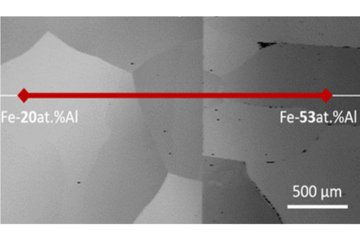All genres
1721.
Talk
Mechanical size effect analysis in metals and biological materials. Invited keynote lecture, Micromechanics Conference II, Oxford, UK (2010)
1722.
Talk
Grain size effects on deformation mechanisms in ferrite/martensite dual-phase steels. Materials Science and Engineering MSE 2010, Darmstadt, Germany (2010)
1723.
Talk
Microstructure and mechanical properties of new lean duplex stainless steels. Materials Science and Engineering MSE 2010, Darmstadt, Germany (2010)
1724.
Talk
Recrystallization and grain growth in ultra fine grained CuZr alloy processed by high pressure torsion. Materials Science and Engineering MSE 2010, Darmstadt, Germany (2010)
1725.
Talk
Multi Phase Cellular Automaton Simulation of the Heat Treatment of Dual Phase Steel. Materials Science and Engineering MSE 2010, Darmstadt, Germany (2010)
1726.
Talk
Characterization of the microstructure of ultra fine-grained materials processed by severe plastic deformation methods in the deformed and the annealed state. Materials Science and Engineering MSE 2010, Darmstadt, Germany (2010)
1727.
Talk
Fast, physically-based algorithms for on-line calculations of texture and anisotropy during fabrication of steel sheets. Materials Science and Engineering MSE 2010, Darmstadt, Germany (2010)
1728.
Talk
Relation of ultrastructure and optical properties in the cuticle of beetles. Materials Science and Engineering MSE 2010, Darmstadt, Germany (2010)
1729.
Talk
Surface Topographies after Nanoindentation and their Utilization to Quantify the Plastic Anisotropy of Gamma-TiAl on the Single Crystal Length Scale. Materials Science and Engineering MSE 2010, Darmstadt, Germany (2010)
1730.
Talk
Mechanical Properties of Laves Phases in the Systems Fe–Nb(–Al) and Co–Nb(–Al) using Polycrystalline, Single-Phase Material. Materiels Science and Engineering 2010 (MSE), Darmstadt, Germany (2010)
1731.
Talk
How nanoindentation experiments and continuum crystal plasticity simulation can efficiently complement TEM dislocation analysis. 2nd Newcastle Nanoindentation Conference, Newcastle upon Tyne, UK (2010)
1732.
Talk
Orientation patterning in copper single crystals: Axperimental observation and laminate analysis in dislocation dynamics. Lehrstuhl für Allgemeine Mechanik, Ruhr-Universität Bochum, Bochum, Germany (2010)
1733.
Talk
Crystal plasticity modeling using dislocation-based finite element methods. Euromech colloquium 505, "Multiscale effects in fatigue of metals", Ecole Polytechnique, Palaiseau, France (2010)
1734.
Talk
Atomic-scale distribution of impurities in CuInSe2-based thin-film solar cells. 52nd International Field Emission Symposium IFES 2010, Sydney, Australia (2010)
1735.
Talk
Laser-pulsed atom probe studies of a complex maraging steel: Laser pulse energy variation and precipitate analysis. 52nd International Field Emission Symposium IFES 2010, Sydney, Australia (2010)
1736.
Talk
Simulation of multiple deformable objects in flow via LBM and FEM. 19th Discrete Simulation of Fluid Dynamics (DSDF), Rome, Italy (2010)
1737.
Talk
Atom Probe Tomography characterization of heavily cold drawn pearlitic steel wire. 52nd International Field Emission Symposium (IFES), Sydney, Australia (2010)
1738.
Talk
Nano-particles and filaments in steels: From understanding to materials design. 52nd International Field Emission Symposium IFES 2010, Sydney, Australia (2010)
1739.
Talk
Recrystallization during annealing of a cold rolled lean duplex stainless steel. Recrystallization & Grain Growth 4 RX&GG, Sheffield, UK (2010)
1740.
Talk
Atomic-scale mechanisms in mechanical alloying - Towards the limits of strength in ductile nano-structured bulk materials. International Symposium on Metastable, Amorphous and Nanostructured Materials (ISMANAM) 2010, ETH Zürich, Switzerland (2010)











